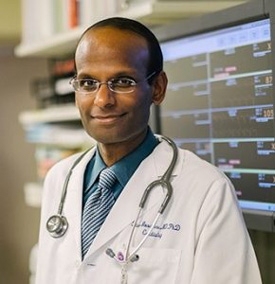In its simplest incarnation, CRISPR-Cas9 is a wildly popular and powerful gene-editing technology which can be thought of as a two-part machine – one that essentially works as a find-and-replace or find-and-remove for your DNA.
The first part of the CRISPR-Cas9 machine is the guide RNA, a short sequence of code designed to match the bit of DNA you want to find. The second part is a protein called Cas9 which acts as a pair of scissors. As a team, the CRISPR-Cas9 tool wanders the DNA molecule of a cell’s nucleus until it finds a sequence that matches the guide RNA.
When it does, the Cas9 gets to work unzipping the DNA and querying it with the guide RNA to make sure it’s a match. If it is, the Cas9 cuts the double-helix in two, resulting in what’s called a double-stranded break. This process allows researchers to efficiently remove or replace a targeted gene, which is why gene editing with CRISPR-Cas9 and similar tools is so significant.
Breaking with Tradition
“Being able to introduce a double-strand break in DNA is what makes CRISPR-Cas9 such a transformative technology for cardiovascular research,” said Dr. Kiran Musunuru, an associate professor of cardiovascular medicine and genetics at the University of Pennsylvania’s Perelman School of Medicine, speaking in Ottawa at the recently held 6th International Ottawa Heart Conference called Precision Medicine in Cardiovascular Disease.
"Being able to introduce a double-strand break in DNA is what makes CRISPR-Cas9 such a transformative technology for cardiovascular research.”
- Dr. Kiran Musunuru

CRISPR-Cas9 allows investigators, and hopefully eventually physicians, to quickly and precisely disrupt disease-causing genes, repair disease mutations and insert new genes that attenuate and potentially cure disease. And because CRISPR-Cas9 has turned out to work very nicely both in vitro (with cells in a dish) and in vivo (in living animals), there is a clear therapeutic implication that it may be a useful tool for preventing and even treating some forms of heart disease.
For example, Dr. Musunuru and his colleagues have shown that genome editing with CRISPR-Cas9 can dramatically reduce blood cholesterol levels in mice by disrupting a gene called PCSK9. This approach indicates that PCSK9 inhibition may have therapeutic potential in the prevention of atherosclerotic cardiovascular disease. Preliminary data suggests that CRISPR-CAS9 may also have potential as a treatment for a variety of other cardiovascular diseases.
Caution: Difficult Questions Ahead
While recent advances in precision genome editing have huge implications for the future care and treatment of cardiovascular diseases, they also pose important questions regarding the ethics of prospective therapies. These concerns are particularly pressing with regards to germline editing, where changes made in the genes of human eggs, sperm or human embryos are permanent and inheritable.
According to a recent survey in the American Heart Association journal, Circulation: Cardiovascular Genetics, a majority of cardiovascular researchers feel the public should be consulted before any clinical application of germline gene editing proceeds.
Dr. Musunuru shares this sentiment and recommends public surveys, hearings and focus groups to explore which uses of germline gene editing are more acceptable than others.
“Precision gene editing is already having a significant effect on cardiovascular basic science research,” said Dr. Musunuru. “We have to start asking ourselves some difficult questions – how far we are willing to go and who gets to decide?”

